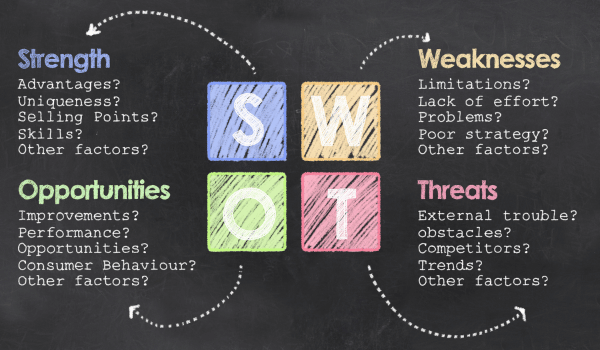Blogs
SWOT Analysis for Restaurant (With examples)
Are you looking to take your restaurant to the next level? It's time to plan for more success with a strategic SWOT analysis for restaurant.
By delving into the Strengths, Weaknesses, Opportunities, and Threats facing your restaurant, you can uncover hidden opportunities to spice up your business strategy.
Let's explore how conducting a SWOT analysis can help you boost your business and beat your competitors.
Benefits of Conducting a SWOT Analysis for Restaurants
One of the main benefits of conducting a SWOT analysis for restaurants is the ability to identify the areas of improvement.
Understanding your strengths allows you to implement them in your marketing campaigns or menu offerings.
On the other hand, recognizing weaknesses of your restaurant is equally important. Identifying the areas needing improvement like slow service or outdated decor, allows you to address these issues proactively.
Moreover, conducting a SWOT analysis helps find out the potential growth opportunities for your restaurant.
Whether you are expanding into catering services or introducing new partnerships, spotting these areas for expansion can drive business growth significantly.
By researching more about potential threats such as rising food costs or increasing competition in your area, you can develop plans to avoid risks and stay ahead of market challenges.
Awareness of internal and external factors impacting your restaurant allows for proactive decision-making and strategic planning.
Internal and External Factors in a SWOT Analysis for Restaurant
When conducting a SWOT analysis for your restaurant, internal factors play a crucial role in determining its current state and potential for growth.

Strengths:
Strengths are the internal factors that set your restaurant apart from the competition. These aspects of your business give you an edge and attract customers.
Consider what sets your restaurant apart from others. Is it your unique menu offerings, exceptional customer service, or prime location? Identifying your strengths can help you capitalize on what makes your restaurant successful.
Weaknesses:
When identifying weaknesses in your restaurant through a SWOT analysis, it's important to be honest and objective. Weaknesses can vary from operational to customer service issues that may impact your business.
Examine areas where your restaurant may need improvement. Acknowledging weaknesses allows you to address them proactively and improve overall operations.
Analyzing these internal factors provides valuable insights that can guide strategic decision-making and drive success for your restaurant.
Examples of internal factors to consider
Strengths as an internal factor
- One strength could be a prime location in a busy area, drawing in foot traffic effortlessly.
- Another strength might be a unique menu offering that stands out from nearby restaurants. This could include signature dishes or special culinary techniques that keep customers coming back for more.
- Exceptional customer service is also a significant strength for any restaurant. Building strong relationships with patrons can lead to repeat business and positive word-of-mouth recommendations, boosting your reputation.
- Efficient operations and well-trained staff contribute to smooth service delivery, enhancing the overall dining experience for guests. These strengths create a solid foundation for success in the competitive restaurant industry.
Weaknesses as an internal factor
- One common area for improvement could be a need for an online presence or outdated marketing strategies, hindering your ability to reach new customers effectively.
- Another area for improvement is high employee turnover rates, leading to inconsistent service quality and training challenges.
- Additionally, more menu options or poor inventory management can be areas for improvement in your restaurant's overall performance.
Addressing these weaknesses head-on is critical to developing strategic solutions for improvement and long-term success in the competitive food industry.
Examples of External Factors in a SWOT Analysis on Restaurant
When conducting a SWOT analysis for restaurant, it's crucial to consider the external factors that can impact your business. These factors are outside your control but play a significant role in shaping your restaurant's success.
Opportunities
One external factor to analyze is opportunities within the market. This could include trends in dining preferences, emerging food technologies, or changes in consumer behaviour.
You can capitalize on these opportunities and stay ahead of the competition by identifying them.
Threats
On the other hand, threats are another important external factor to assess. These could be anything from new competitors entering the market, economic downturns affecting consumer spending, or even changing regulations impacting the industry.
Being aware of potential threats allows you to mitigate risks and safeguard your restaurant's operations.
By evaluating opportunities and threats as part of your restaurant's SWOT analysis, you'll gain valuable insights into how external factors influence your restaurant's performance.
Examples of Opportunities as an external factor
When conducting a SWOT analysis for your restaurant, exploring opportunities can provide valuable insights into potential growth areas. Opportunities are external factors that your restaurant could leverage to its advantage.
- Identifying opportunities could include analyzing trends in the food industry, such as increasing demand for healthy options or plant-based menus.
- It could also involve looking at emerging technologies that streamline operations and enhance customer experience. Favouritetable's restaurant booking software is one such example.
- Expanding your restaurant's reach through catering services or partnerships with local businesses presents another opportunity worth considering.
- Additionally, tapping into the growing online ordering and delivery services trend can open up new revenue streams for your establishment.

By recognizing and capitalizing on these opportunities, you can position your restaurant for sustainable growth and success in a competitive market.
Examples of Threats as an external factor
Threats in a SWOT analysis for your restaurant are external factors that could harm your business operations. These threats can come from various sources and must be carefully considered to mitigate risks.
- One common threat is increased competition in the area, leading to losing customers to other dining establishments. Another threat could be changing consumer preferences or trends that may impact the demand for your menu offerings.
- Additionally, economic downturns or fluctuations in the market can pose a threat to your restaurant's profitability. For instance, rising food costs or supply chain disruptions can directly affect your bottom line.
- Moreover, negative reviews on social media platforms or review websites can damage your restaurant's reputation and deter potential customers from dining with you.
It is essential to stay vigilant and proactive in addressing these threats to ensure the long-term success of your restaurant business. You can develop strategies to overcome challenges and thrive in a competitive industry by identifying potential risks early.
How to Perform a SWOT Analysis for Your Restaurant
Step 1
Start by gathering a diverse team that includes chefs, servers, and managers.
Together, brainstorm the internal strengths and weaknesses of your establishment.
Consider factors like brand reputation, menu variety, customer service quality, and operational efficiency.
Step 2
Next, shift focus to external opportunities and threats in the market. Look at trends in dining preferences, local competition, economic conditions, and technological advancements impacting the industry. Understanding these factors can help you identify potential growth areas or risks to be mindful of.
Step 3
Once you have compiled this information, create a clear SWOT matrix outlining each element.

Step 4
Analyze how strengths can be leveraged to seize opportunities and how weaknesses could be improved to mitigate threats. Use this insight to develop strategic initiatives that capitalize on your restaurant's strengths while addressing any vulnerabilities uncovered during the analysis process.
Step 5
Regularly revisit and update your SWOT analysis as market conditions evolve to ensure your restaurant remains agile and competitive in the ever-changing food service landscape.
Tips for Using the Results of Your SWOT Analysis to Improve Your Restaurant
By utilizing the insights gained from your SWOT analysis, you can make informed decisions to enhance your restaurant's performance and stay ahead in the competitive industry.
Take action on identified opportunities, address weaknesses, leverage strengths, and mitigate threats to create a more resilient and successful business.
Remember that conducting regular SWOT analyses will help you adapt to changing circumstances and continuously improve your restaurant's operations.
Keep analyzing, strategizing, and evolving to ensure long-term success in the dynamic restaurant landscape.




